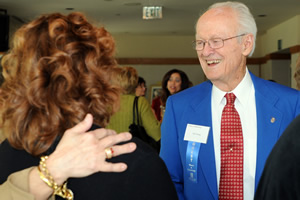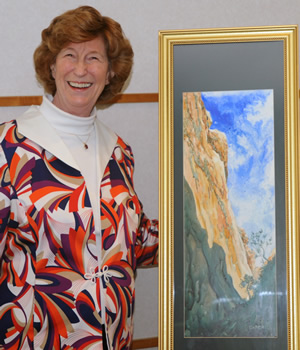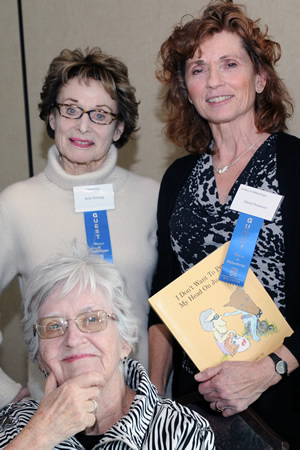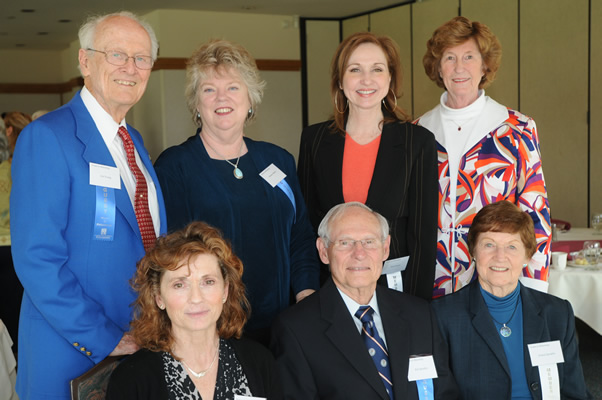The Silver Tsunami
Baby Boomers Blaze Aging's New Path
March 2, 2010
By Valerie Orleans
They climb Kilimanjaro. Write poetry. Paint pictures. Counsel their peers. Donate their time, talent and treasure. And they have lots of practical suggestions to make about aging well.
Those suggestions provided food for thought when a panel of expert baby boomers addressed a recent meeting of Cal State Fullerton's Women and Philanthropy group. The panel discussion, titled "The Zoom Boom: Inspiration for the Coming Silver Tsunami," was held Feb. 11 at the Coyote Hills Golf Course in Fullerton.
On the first day of 2011, baby boomers will start turning 65, according to Kate Peters, a musical storyteller, actor, public speaker and author, and the coming “silver tsunami” will have far-ranging effects on society.
“This group, many of whom have renamed themselves the ‘zoomers,’ look at aging very differently,” she said. "They are well-educated, politically savvy, socially conscious and they will want to continue to do good things as they age. What they didn’t accomplish in their youth, they will want to accomplish in their maturity.”
And, they'll want to stay in their own homes and "age in place" as long as possible. Boomers are changing what it means to grow older.

Jim Young, founding chair of the university's Theater and Dance Department, greets well-wishers at a recent presentation, where he recited his poem. Photo by Paula Selleck
Assistive Technology
At Cal State Fullerton, plans are underway to develop a CATLab (California Assistive Technology Laboratory). In the early phase, gerontologists are working with faculty in the College of Engineering to determine what types of assistive devices would make it easier for seniors to stay in their homes and remain healthy.
“We need the CATLab to advance the development and testing of assistive technology,” said Pauline Abbott, director of the university's Institute of Gerontology and the Ruby Gerontology Center. “For instance, have you noticed how small cell phones have become? For a senior with limited eyesight and finger dexterity, that isn’t necessarily a good thing. Our quest is to take technology and realign it for use among the older population.”
Other ideas being considered:
- An ankle bracelet implanted with a GPS system so to aid tracking of Alzheimerís patients
- Dolls and stuffed animals with recording devices linked to nursing stations. (Research shows that many people with dementia often won't talk to healthcare personnel, but they will speak to a doll or stuffed animal.)
- A special computer mouse device that can counter the shaking hand motions of Parkinsonís patients
“This is just the tip of the iceberg,” Abbott said. “We know there are lots of ideas out there and our goal is to determine whether and how they can be built. We also want to conduct lots of testing.”
In addition to developing new technologies, "we want to focus on testing existing technologies to ensure the health and safety of our older population,” she added.
The goal of the CATLab is to incubate ideas to the prototyping stage.
10 Things About Retirement

Betty Redmon with one of her water colors. Photo by Paula Selleck
After working at USC for 28 years, the last four as executive director of the USC Emeriti Center and the bi-national Association of Retirement Organizations in Higher Education, Betty Redmon decided to retire to something rather than retire from something.
“I had the greatest job in the world,” she said, “But I needed the time and energy to pursue activities that I love — particularly writing and painting.”
To keep healthy, she’s involved in Cal State Fullerton’s Center for Successful Aging which offers exercise programs specifically tailored for older adults. To inspire creativity, she joined CSUF’s Osher Lifelong Learning Center (OLLI), where she takes classes in ceramics and watercolor painting. (She sells her paintings under her maiden name Daron.)
In 2007, Redmon's 95-year-old mother moved in with her.
“I’m glad I had the opportunity for us to share time together,” she said. “We both joined the Yorba Linda Senior Chorus and even performed at the Nixon Library.”
Together they also enrolled in OLLI’s “Life Storybook” class where they co-authored two books.
“It’s her memories and my writing,” Redmon said. “The first semester, we only got her through high school.”
Redmon said she believes that keeping her mother busy and engaged added two quality years to her life. Her mother, now 98, lives in Dallas with another daughter.
Redmon shared her list of’s list of “10 Things I’ve Learned About Retirement:”
- Tennis shoes are far more comfortable than high heels.
- An exercise routine works only if you actually do it.
- Although I hate routine and get bored easily, a degree of routine holds life together.
- Try to leave your work in good shape and at a good time, and then drop the guilt about what you failed to accomplish.
- Those photos you haven’t yet found time to organize will become a delightful surprise when they suddenly surface from underneath the clutter.
- Setting goals keeps me from spending too much time working jigsaw puzzles.
- Closets, once straightened, just get cluttered again.
- Your grandchildren keep you young, even when your knees won’t let you play on the floor with them.
- Some people retire because they have to, perhaps for health or to care for a loved one, and they adjust to their situations and become either more loving or more embittered. Some people retire because they are bored with their jobs, or hate commuting, or dislike their bosses, or are just tired. These people often wish they were back at work in six to 12 months. Some people retire because there are things they need time to do that will bring more fulfillment than their jobs.
- Age happens.
Climb Every Mountain
When their daughters were young, the Spradlins would all go car camping or skiing in the Sierras or waterskiing in Colorado.
For the former electrical engineer (Kirt) and teacher (Donna), retirement offered the chance to spend even more time camping, backpacking and mountaineering.
They climbed Mt. Whitney, the highest summit in the contiguous United States.
The couple (now in their 80s) has scaled Whitney several times over now. They also hiked the entirety of the John Muir trail in Yosemite.
“We did it in two summers,” Kirt said. “The first year, we backpacked 100 miles in ten days. The next summer, we backpacked the remaining 150 miles in 15 days.”
Then it was on to Mt. Everest.
“We are always the oldest in any climbing group but we train extra-hard,” Kirt said. “In fact, during our Everest climb, we also managed to make three side trips in addition to reaching base camp at 18,500 feet.”
From Everest, it was on to Mt. Kilimanjaro.
“We trained for that one in the Grand Canyon,” Kirt said. “We went down and up the canyon twice in one week — with full backpacks.”
The Spradlin’s message? Being older doesn’t mean giving up all the activities you love. Their love of hiking has helped them maintain their health and continue to lead the active life they enjoy.
Exchanging Wisdom

Two of Cheryl Svensson's students from OLLI — Bette Henning, left, and Jean Franks, seated. Photo by Paula Selleck
When Cheryl Svensson began working with older adults as a social work assistant in the 1970s, things were different.
“In nursing homes of that era, there wasn’t the kind of care and independence that is encouraged today,” she said. “We’ve really come a long way.”
Twenty-one years ago, Svensson designed a course for elders called “Growing Wiser” (since renamed “Wisdom Exchange”).
“It’s pretty funny when you think about it,” she said. “I thought I was going to meet with these older adults and share all of my wisdom. Instead, they taught me.”
Svensson also teaches classes in autobiographical studies and guided autobiography in several venues throughout Southern California.
Today Svensson teaches the courses at OLLI and asks her students: “What are you going to do with the gift of a long life?”
“We all are creative,” she said. “The idea of my class being an exchange of ideas is just that — acknowledging that we all have something to share. My students are writers, artists, teachers, business owners. They have lived through triumph and despair and we can learn much from them.”
And don’t discount older adults’ feelings, she said.
“One of my students, who was in her 70s, had her heart broken by a man she was seeing,” Svensson said. “But, instead of moping around after he left her for another woman, she developed a cartoon book. And, I’ll tell you this: Her former beau was not drawn in the most flattering light.
“Careful, folks,” she continued with a laugh. “Although our hearts can still be broken, we are now much more ingenious.”
Aging on Stage
Jim Young, founding chair of the Cal State Fullerton's Theater and Dance Department and an associate vice president for Academic Programs, retired in 1991 but remains actively involved in a wide range of the university's programs. In fact, he played roles in two CSUF theatre productions last year: Tennessee Williams’ “Night of the Iguana” and Anton Chekov’s “Ivanov.”
His name graces a new theater in the university’s Performing Arts Center.
“As a resident of Morningside who is involved in many different activities, I don’t have time to think about growing old. After all, I’ve turned 44 twice,” he told the laughing crowd. “There is simply too much to do.”
Young recommends that older adults learn to rely on themselves as much as possible.
“It’s easy, sometimes, to use a little cart to get places instead of walking,” he said. “But once you start, it becomes harder and harder to get away from those little vehicles.”
He also recommends focusing on others.
“As we think of others, we forget about ourselves,” he said.
Young is an active donor to Cal State Fullerton. He frequently visits the campus and has appeared more than 600 times in a play he wrote about Paul Harris, the founder of Rotary International.
“I was active in Rotary and I was telling my Rotary friends, ‘You know, someone should write a play about Paul Harris and all the wonderful work he — and Rotary — have done,” he said. “My friend looked at me and said, ‘Well, you look like him. Why don’t you do it?’”
The one man show (similar to Hal Holbrook’s portrayal of Mark Twain) has taken Young all over the nation and abroad — including a performance in northwest India.
Young continues to write and credits a class, "Poetry for Pleasure," he takes through OLLI for helping him find his inner poet.
“The only requirement of the class is to show up,” he said. “You can read, listen or write poetry.”
The class recently published its third book of poems.
“The important thing to remember is that we are all important to someone,” he said. “I had a dear friend, who was in nursing care and feeling very depressed. She said to me, ‘I’m not of any value. I’m not producing anything. It would be better if I just died.’
"But then I reminded her," he said with a chuckle, “But, Hazel — what would these people do for jobs without you?”


